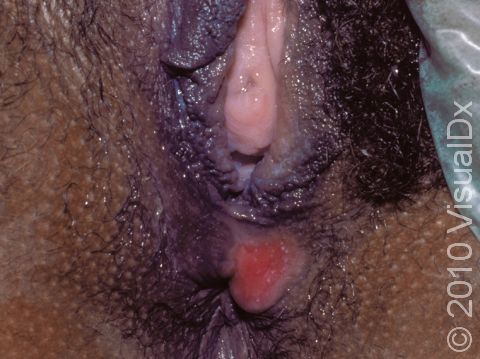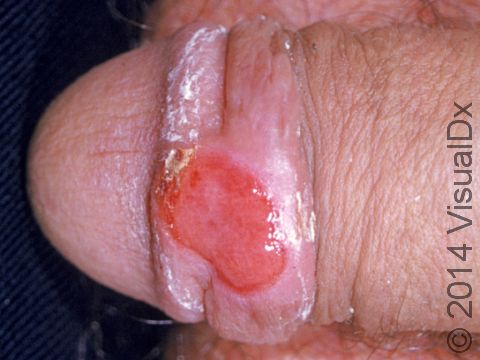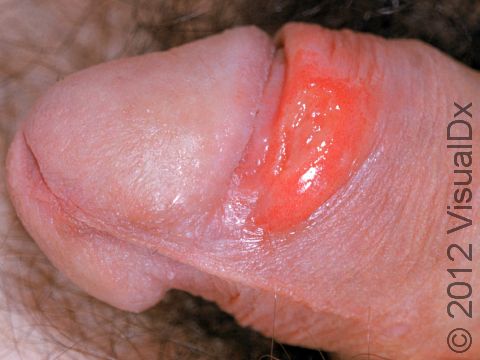Primary Syphilis
Primary syphilis is the name given to the first part of the disease caused by infection with the sexually transmitted bacterium, Treponema pallidum. The disease is divided into 3 parts, and it is important to recognize the first part (which involves the skin) so that you can get treated before the disease progresses to the second and third parts, which affect the brain and cause early death. The classic skin lesion of primary syphilis is a red bump on the genitals that opens into a sore, called a chancre. The sore is typically painless and will heal on its own without treatment, but the disease will still be present, so it is very important to show the sore to your doctor. If treated early, syphilis can be completely cured. Syphilis, like other sexually transmitted diseases, is passed from person to person during oral, vaginal, or anal intercourse. It can also be passed from a mother to a baby during birth. If a baby gets syphilis, he/she often dies.
Who's At Risk?
Syphilis infection can occur in any sexually active person, but it tends to affect young men (15–25 years old) who have sex with other men, sex workers, and people who have sex with sex workers. The disease is more common in the southern states and in urban areas in general.
Signs & Symptoms
Initially, a dusky red, flat spot appears at the site of inoculation and is easily missed. Then, a painless ulcer (chancre) appears 18–21 days after initial infection. Genital sites in females affected are the cervix, vagina, vulva, and clitoris. Cervical and vaginal infections may not be recognized. In men, the chancre is easily seen on the penis. Other sites are limited only by human ingenuity and imagination. Other common sites for syphilis are around the mouth (perioral) and between the buttocks (perianal) areas.
Chancres vary in size from a few millimeters to several centimeters. A chancre is usually painless, solitary, and shallow, with a sharp border and a raised, hard edge. About 70–80% of patients have rubbery, non-tender, swollen lymph nodes, often on only one side of the groin, during the first week of infection.
If untreated, the chancre will remain present for 1–6 weeks. If treated, it heals without scarring in 1–2 weeks.
Self-Care Guidelines
Syphilis, in the primary stage, is highly contagious and can heal without therapy, making it easy to be mistaken for something less serious. If you are sexually active and suspect you have been exposed to syphilis or have an ulcer in the mouth, genital area, or anal area, you should seek medical care immediately. You should avoid any further sexual activity and notify any previous sexual partners.
Syphilis can be prevented by abstaining from casual sexual activity and using condoms correctly during any sexual contact. If you are in a long-term relationship, make sure that you know your partner’s sexual history or ask that your partner is tested prior to engaging in sexual activity.
Treatments
Blood and fluid tests will be done to look for other infectious sexually transmitted diseases, which are often present along with syphilis.
Antibiotics (penicillin, doxycycline, or tetracycline) will be given, and blood tests will be done again; you will be followed for 2 years to be sure the infection is gone.
Do not engage in sexual activity until the chancre is healed and follow-up blood tests have shown that the infection has been cured.
Visit Urgency
See your doctor immediately if you are sexually active or suspect you have been exposed to someone with syphilis. DO NOT attempt self-care if you have any ulcer in the genital, mouth, or anal area. Avoid sexual activity and notify your sexual partner(s) of your illness. Additionally, you should seek medical advice if you have had intimate contact with someone with syphilis, have been using intravenous drugs, or if you have engaged in sex with multiple or unknown partners.
References
>Bolognia, Jean L., ed. Dermatology, pp.1271-1282. New York: Mosby, 2003.
Freedberg, Irwin M., ed. Fitzpatrick’s Dermatology in General Medicine. 6th ed. pp.1263, 2164-2165. New York: McGraw-Hill, 2003.
Last modified on August 16th, 2022 at 2:44 pm

Not sure what to look for?
Try our new Rash and Skin Condition Finder


